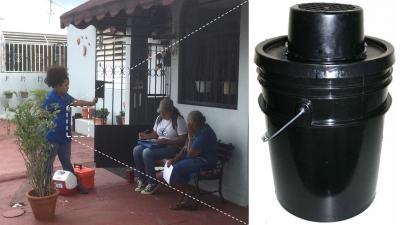
Credit: Tyler M. Sharp (CC BY 4.0)
The U.S. Centers for Disease Control and Prevention (CDC) recently developed an Autocidal Gravid Ovitrap (AGP trap) that attracts and captures female mosquitos looking for a site to lay eggs. Now, researchers writing in PLOS Neglected Tropical Diseases report that AGO traps successfully protected people from infection with chikungunya virus (CHIKV) in communities in Puerto Rico.
The lack of effective tools to control Aedes aegypti mosquito populations has resulted in the continued expansion of dengue virus, Zika virus and CHIKV. Some recent attempts at curbing mosquito populations have resulted in reductions in mosquito density but not reductions in human disease. AGO traps consist of a pail with hay and water to attract egg-bearing female mosquitos and a sticky lining to which the insects adhere. Previous studies have shown that placing three AGO traps outside of 85% of homes in a community resulted in an 80% reduction in adult mosquito populations but the studies did not assess rates of mosquito-borne diseases in humans.
In the new work, Tyler Sharp, of the CDC, and colleagues randomly selected 290 households in Puerto Rican communities that had AGO trap interventions and 349 households in communities without AGO traps. 175 household members from intervention communities and 152 from non-intervention communities were enrolled in the study. Blood samples were collected from each participant to detect CHIKV infection and surveys recorded demographic information as well as data on mosquito repellant and bed net use and frequency of mosquito bites.
A total of 114 participants (34.9%) were seropositive for CHIKV. Among people who spent most of their daytime hours inside the community they lived in, 10.3% were seropositive for CHIKV in communities with AGO traps whereas 48.7% were positive for CHIKV in communities without traps. Among all participants, including those who did not spend as much daylight time within the community, 26.1% were seropositive for CHIKV in the intervention communities and 43.8% were positive in communities without traps.
“AGO traps are a novel chemical-free, effective approach to control Ae. aegypti populations and provide protection from infection with the pathogens that these mosquitos transmit,” the researchers say. “Further evaluations should determine if AGO traps are sustainable and effective in larger scale community trials.”
###
Citation: Sharp TM, Lorenzi O, Torres-Velásquez B, Acevedo V, Pérez-Padilla J, et al. (2019) Autocidal gravid ovitraps protect humans from chikungunya virus infection by reducing Aedes aegypti mosquito populations. PLOS Neglected Tropical Diseases 13(7): e0007538. https:/
Funding: The authors received no specific funding for this work.
Competing Interests: The authors have declared that no competing interests exist. Autocidal gravid ovitraps (AGO traps) used in this study were developed and constructed by CDC personnel (RB). Rights for the AGO trap patent (US 9.237,741
B2) were transferred to the US Government (Executive Order 10096). Eventual royalties derived from trap sales by licensed companies follow 15 U.S.C. 3710c.
In your coverage please use this URL to provide access to the freely available paper: http://journals.
Media Contact
PLOS Neglected Tropical Diseases
[email protected]
Related Journal Article
http://dx.




